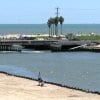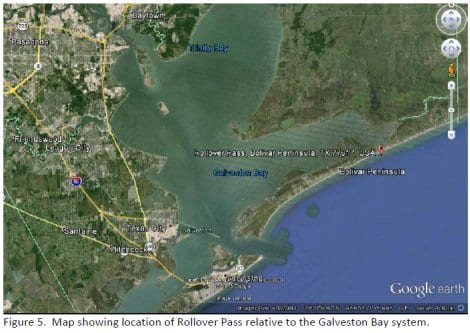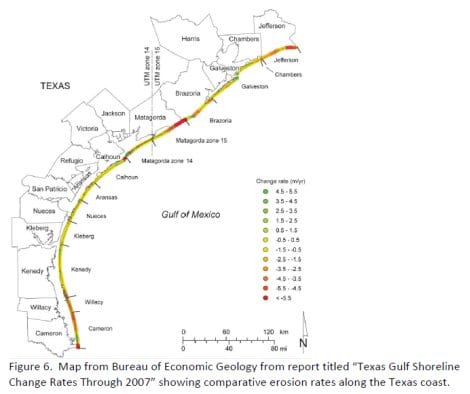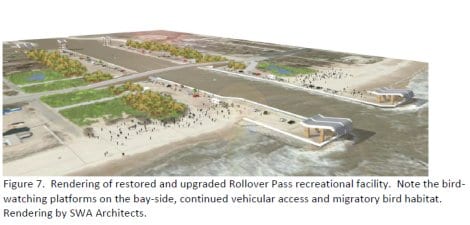 By Jim Blackburn
By Jim Blackburn
Rollover Pass is a fabulous public access fishing venue that connects the Gulf of Mexico to East Bay in the Galveston Bay complex and is located on the Bolivar Peninsula. This artificial pass was completed in 1955 by the Texas Fish and Game Commission on property owned by the Beaumont Rod, Reel and Gun Club. Under the terms of the easement agreement between the State and the Club, the state was allowed to construct and maintain Rollover Pass on the land owned by the Club. The purpose of constructing Rollover Pass was to increase the salinity in East Bay, to increase the growth of sea grasses in East Bay and to help marine fish move to and from spawning and feeding areas. A map showing the location of Rollover Pass is shown in figure 5.

Map showing location of Rollover Pass relative to the Galveston Bay system
In 2010, the General Land Office of the State of Texas, led by Commissioner Jerry Patterson, applied to the U.S. Army Corps of Engineers for a permit to fill in Rollover Pass, thereby seeking to close this public recreation asset that is used by all types of fishermen and women of all ages and ethnicities including disabled veterans and other people who need to fish near their cars and have no alternative locations. Additionally, the recreational fishery of East Bay, which is currently superb, is enjoyed by many excellent anglers and fishing guides. The GLO submitted this application even though they had no ownership interest in the property. Although this application was opposed by the landowner – the Beaumont Rod, Reel and Gun Club – along with many members of the Gilchrist Community Association (GCA) as well as countless other pass users, the permit allowing Rollover Pass to be filled was issued by the Corps in August, 2012. The Club and the GCA then filed suit against the Corps and the GLO in federal court in April, 2013. The trial is scheduled for 2014.
Neither the Club nor the GCA have much money or political influence, but they are committed to fishing, equal access, fair play and honesty, and they filed suit because something “does not smell right” about this closure. To start with, the GLO has no ownership in the land and does not have the power of eminent domain, yet they represented to the Corps that they could obtain this property. As the Club is unwilling to sell, that may seem impossible at first blush, but the GLO has “convinced” Galveston County to undertake condemnation action against the Club as set out in a Memorandum of Agreement between the GLO and Galveston County executed in early October, 2013. However, according to public statements by politicians with knowledge, the County really did not want to condemn the land, but felt that they had to agree in order to continue to receive grants and other assistance from the GLO. Arguably, Galveston County was coerced by the GLO to agree to condemn Rollover Pass. That’s pretty nasty, even for Texas politics.
GLO has identified three reasons to support closing Rollover Pass. First according to the GLO, closing the Pass would “restore” East Bay to its original condition. Second, closing the Pass would stop sediment build-up in the Gulf Intracoastal Waterway (GIWW) supposedly caused by the operation of Rollover Pass and costing an additional $1 million per year in dredging costs. And third, closing Rollover Pass would stop or significantly reduce beach erosion on the southwest side of the Pass. The Club, GCA and I question the validity of these rationales and the accuracy of the studies that support these claims.
First, consider the restoration of East Bay. East Bay in its natural condition was dominated by freshwater inflows, primarily from Oyster Bayou and various marsh drains on the northern shoreline of East Bay. In fact, the original reason for opening Rollover was to increase the salinity of East Bay because it was often too fresh. Regardless, the goal of restoring East Bay is currently not possible because in 2007, the Corps and the GLO permitted the diversion of Taylor’s Bayou in Jefferson County southward into the GIWW. During high flow situations, Taylor’s Bayou will now flow south through the so-called Needmore Diversion ditch and will empty millions of cubic feet of floodwaters into the GIWW. According to Corps documentation associated with the permitting of the diversion, water surface levels will rise from this diversion ditch westward into East Bay during flood discharges. To date, no analysis of the closure of Rollover Pass has considered the additional freshwater diverted into East Bay by this permitted ditch that is currently being constructed. In fact, the modeling submitted by the GLO to the Corps did not even include any inflows from Oyster Bayou much less from Needmore. When this diversion is completed and if the Pass is closed, East Bay could be ruined as a marine fishery during wetter years. Far from restoring East Bay, the closure of the Pass will likely overwhelm East Bay with too much freshwater, a rare situation on the Texas coast where bays are normally killed because of too little freshwater inflow. And the real shame is that this issue was not evaluated by either the GLO or the Corps.
Second, consider the siltation of the GIWW. If siltation were a major concern, neither the State nor the Corps would have allowed the Needmore diversion to be permitted or constructed. Taylor Bayou during flood stage is loaded with sediment. Perhaps more importantly, the only quantification of additional dredging that has been established as attributable to the Pass in the Corps’ background documents is 15,000 cubic yards a year (about $60,000 per year), a far cry from the hundreds of thousand cubic yards a year at a cost of $1 million put forth in publicity documents. And third, any sand coming in from the Pass could be reduced by the construction of a jetty along the north edge of the Pass and the Gulf such as was proposed in the original design of the Pass.
Finally, consider the issue of beach erosion. Beach erosion is prevalent throughout the Bolivar Peninsula and Galveston Island. It certainly exists east of High Island in Jefferson County along the beach where U.S. 87 had to be closed due to erosion. All of this erosion is not caused by Rollover Pass but rather from the lack of sand and sediment sources from the Gulf and possibly the Mississippi River. The closure of the Pass will have no effect on the presence of, or rate of, erosion at most places along the upper Texas coast. A report by the Bureau of Economic Geology titled “Texas Gulf Shoreline Change Rates Through 2007” shows in Figure 16 that the shoreline erosion in and around Rollover Pass is less than in many other coastal shoreline areas, including Jefferson County east of High Island and the Follet’s Island area west of San Luis Pass. There is some localized increase erosion southwest of the Pass, but it is labeled as a moderate rate by the BEG and is not out of line with erosion rates in this part of the coast as is shown in Figure 6.

Map from Bureau of Economic Geology from report titled “Texas Gulf Shoreline Change Rates Through 2007” showing comparative erosion rates along the Texas coast
So, the question remains: “Why is the GLO trying to close Rollover Pass?” Rollover Pass does attract lower income, racially mixed crowds. It is a poor man and woman’s best place to have a chance to catch a really nice fish. Are we rushing to judgment here, going to the extent of strong-arming Galveston County into condemning the land, so that the GLO can appease some major donors by closing the Pass?
I am not sure if I am going to get the answers to this situation, but I intend to try. In federal court, the Club and GCA have claimed that the GLO has violated the U.S. Constitution in its actions to take control and close a Pass that it does not own. We are challenging the Corps on the basis that, in making their analysis of environmental impact they failed to consider the cumulative ecological impacts of the Needmore Diversion, a project that they permitted and know all about, yet a project that was left out of the impact analysis by both the GLO and the Corps. We have questions about the accuracy of fact-findings that were completed by the Corps. And we are alleging that the closure of Rollover Pass will cause major socio-economic impacts on the Gilchrist community as well as on all users of Rollover Pass, particularly those who are disabled.
There are multiple issues and concerns about losing the Pass. I am particularly concerned about the potential harm to East Bay resulting from the closure. There are many of you who like to fish and, by my evaluation, fishing will be harmed. East Bay is a wonderful fishing hole and Rollover Pass is the reason why. Capt. Mickey Eastman once told me that he had no doubt that if he fished the Pass hard, he could catch a bona fide trophy trout there. Where else can you fish from the bank and have such a chance?
There are solutions that would allow Rollover Pass to stay open and that would reduce whatever problems are attributable to the Pass. The original plan for Rollover had a jetty that intercepted sediment and kept it from moving into East Bay. To the extent that concern exists that Rollover is actually causing such a problem, this jetty would solve it. And there is no doubt that the Rollover Pass infrastructure, which was damaged by Hurricane Ike, could be restored and repaired and turned into the recreational fishing jewel of the Upper Coast. All of this is possible if there were any interest in making it happen. An image of what Rollover Pass could be is shown below (without the jetty).

Rendering of restored and upgraded Rollover Pass recreational facility. Note the bird-watching platforms on the bay-side, continued vehicular access and migratory bird habitat. Rendering by SWA Architects
If you care about the ecology of East Bay or about fairness in access to fishing, you might want to consider supporting the litigation that we have filed. This effort will be underwritten by some pro bono legal efforts, but we need to pay experts and a little income for the lawyers is always appreciated. If you want to donate to the Gilchrist Community Association Rollover Pass Fund, please send your contribution to Ted Vega, Gilchrist Community Association, P.O. Box 186, High Island, Texas 77623. The Rollover Pass website can be found at
http://www.rolloverpasstexas.com/.

 Posted in
Posted in 
























Fantastic beat ! I wish to apprentice whilst you amend your web site, how could i subscribe for a blog web site?
The account aided me a appropriate deal. I have been a little bit familiar of this your
broadcast offered brilliant clear concept
Feel free to surf to my homepage :: traffic school Miami Gardens
My daddy told me a long time ago and I quote…” it ain’t about right and wrong, it’s all about revenue…”
If the GLO would study the “barges” and their forcefull propella wash, they would know that the barges cause silt build up as well by pushing sand around.
The $1M price tag is for keeping the economic push through the Intracoastal Canal so the “barges” can deliver their goods……
Leave Roll Over Pass and the fishing alone!